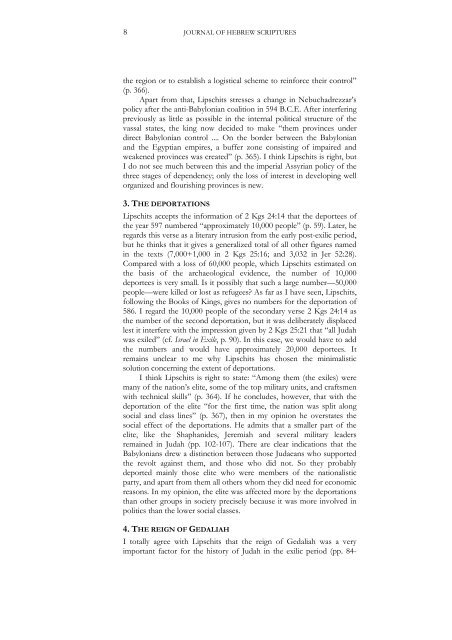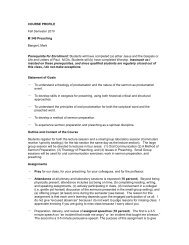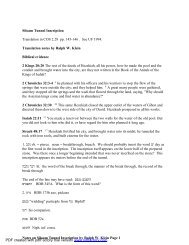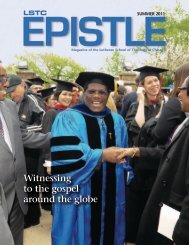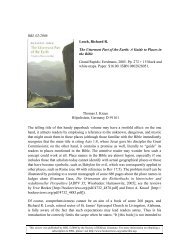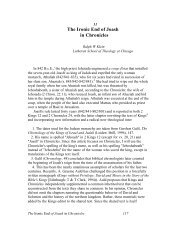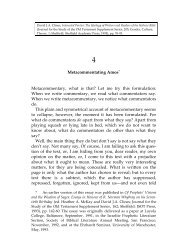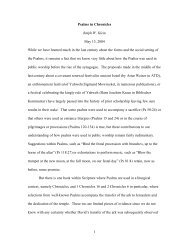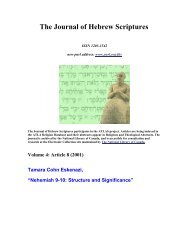Download this PDF file - University of Alberta - Journal Hosting
Download this PDF file - University of Alberta - Journal Hosting
Download this PDF file - University of Alberta - Journal Hosting
You also want an ePaper? Increase the reach of your titles
YUMPU automatically turns print PDFs into web optimized ePapers that Google loves.
8JOURNAL OF HEBREW SCRIPTURESthe region or to establish a logistical scheme to reinforce their control”(p. 366).Apart from that, Lipschits stresses a change in Nebuchadrezzar’spolicy after the anti-Babylonian coalition in 594 B.C.E. After interferingpreviously as little as possible in the internal political structure <strong>of</strong> thevassal states, the king now decided to make “them provinces underdirect Babylonian control .... On the border between the Babylonianand the Egyptian empires, a buffer zone consisting <strong>of</strong> impaired andweakened provinces was created” (p. 365). I think Lipschits is right, butI do not see much between <strong>this</strong> and the imperial Assyrian policy <strong>of</strong> thethree stages <strong>of</strong> dependency; only the loss <strong>of</strong> interest in developing wellorganized and flourishing provinces is new.3. THE DEPORTATIONSLipschits accepts the information <strong>of</strong> 2 Kgs 24:14 that the deportees <strong>of</strong>the year 597 numbered “approximately 10,000 people” (p. 59). Later, heregards <strong>this</strong> verse as a literary intrusion from the early post-exilic period,but he thinks that it gives a generalized total <strong>of</strong> all other figures namedin the texts (7,000+1,000 in 2 Kgs 25:16; and 3,032 in Jer 52:28).Compared with a loss <strong>of</strong> 60,000 people, which Lipschits estimated onthe basis <strong>of</strong> the archaeological evidence, the number <strong>of</strong> 10,000deportees is very small. Is it possibly that such a large number—50,000people—were killed or lost as refugees? As far as I have seen, Lipschits,following the Books <strong>of</strong> Kings, gives no numbers for the deportation <strong>of</strong>586. I regard the 10,000 people <strong>of</strong> the secondary verse 2 Kgs 24:14 asthe number <strong>of</strong> the second deportation, but it was deliberately displacedlest it interfere with the impression given by 2 Kgs 25:21 that “all Judahwas exiled” (cf. Israel in Exile, p. 90). In <strong>this</strong> case, we would have to addthe numbers and would have approximately 20,000 deportees. Itremains unclear to me why Lipschits has chosen the minimalisticsolution concerning the extent <strong>of</strong> deportations.I think Lipschits is right to state: “Among them (the exiles) weremany <strong>of</strong> the nation’s elite, some <strong>of</strong> the top military units, and craftsmenwith technical skills” (p. 364). If he concludes, however, that with thedeportation <strong>of</strong> the elite “for the first time, the nation was split alongsocial and class lines” (p. 367), then in my opinion he overstates thesocial effect <strong>of</strong> the deportations. He admits that a smaller part <strong>of</strong> theelite, like the Shaphanides, Jeremiah and several military leadersremained in Judah (pp. 102-107). There are clear indications that theBabylonians drew a distinction between those Judaeans who supportedthe revolt against them, and those who did not. So they probablydeported mainly those elite who were members <strong>of</strong> the nationalisticparty, and apart from them all others whom they did need for economicreasons. In my opinion, the elite was affected more by the deportationsthan other groups in society precisely because it was more involved inpolitics than the lower social classes.4. THE REIGN OF GEDALIAHI totally agree with Lipschits that the reign <strong>of</strong> Gedaliah was a veryimportant factor for the history <strong>of</strong> Judah in the exilic period (pp. 84-


